The epicentre of the global coronavirus pandemic is no longer in Italy or Spain. Instead, New York is now leading the unenviable world tally.
The appeal of the Big Apple has always been that it has so much going on. That there’s nothing you can’t do. But New York City – a place we’re told “if you can make it there, you can make it anywhere” – is currently “on pause”, by order of New York Governor Andrew Cuomo.
From schools and 100 per cent of non-essential workplaces, to Broadway shows, restaurants, bars, concerts, galleries, museums, sporting matches and so much more – the lights have temporarily gone out as the city grapples to get a handle on the coronavirus pandemic that has ravaged the world.
Eighty one days ago, the US didn’t have a single confirmed case of coronavirus in the country. As of Thursday afternoon, almost half a million Americans have tested positive for the disease and more than 16,200 have died.
Today, the Empire State has officially overtaken every country and US state to become the COVID-19 capital of the world, with a total of 159,937 confirmed coronavirus cases — a jump of more than 10,000 new cases from the day before. There have been 7067 deaths as a result of the contagion in the state so far, with a record 799 deaths overnight.
Following the US, Spain and Italy have recorded 152,446 and 139,422 COVID-19 cases, respectively, according to the latest data from Johns Hopkins University.
Meanwhile, New York City has emerged as the global epicentre of the pandemic, with more than half of the state’s cases confined to the dense region.

Workers wearing personal protective equipment bury bodies in a trench on Hart Island in the Bronx.Source:AP

Medical personnel move a deceased patient to a refrigerated truck serving as make shift morgues at Brooklyn Hospital Centre on April 09, 2020 in New York City. Picture: Angela Weiss/AFP.Source:AFP
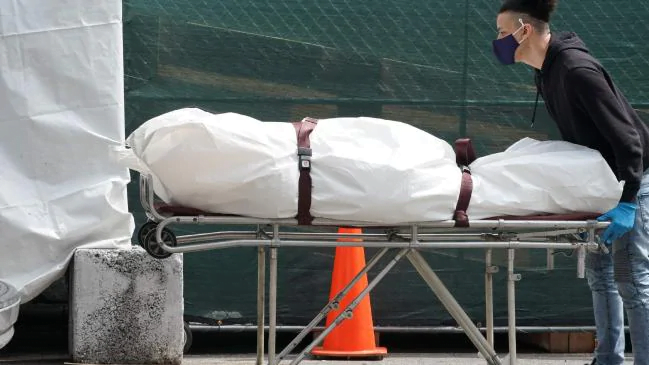
A body is moved from a refrigeration truck serving as a temporary morgue to a vehicle at the Brooklyn Hospital Centre on April 8, 2020. Picture: Bryan R. Smith/AFP.Source:AFP
The Big Apple never saw this coming. And even once it was on the doorstep, the spread was so rapid that many residents struggled to grasp the gravity of the pandemic before its risks were fully visible.
Just a few weeks ago, I was knocking back wines with friends and showing some cheese who was boss in New York’s Central Park on a sunny Sunday afternoon. Only a handful of people in the US had tested positive for COVID-19 at that stage, with the first person diagnosed in NY only 39 days ago.
Last week, I returned to the park for work to visit an emergency field hospital – typically used in war zones – equipped with an intensive care unit (ICU) and ventilators. Within hours of opening, the 68-bed site was at capacity. It’s one of several makeshift hospitals and morgues set up in NY to deal with an overflow of coronavirus patients and corpses in public facilities.
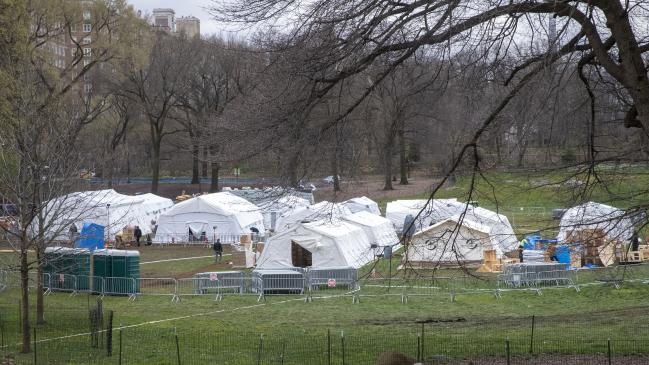
Samaritan’s Purse crew and medical personnel preparing to open a 68-bed emergency field hospital specially equipped with a respiratory unit in New York’s Central Park, Tuesday, March 31, 2020, in New York. Picture: Mary AltafferSource:AP
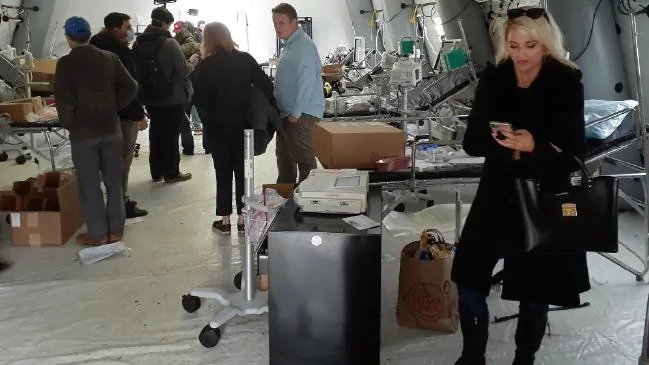
News.com.au’s US Correspondent Megan Palin (right) inside the Samaritan’s Purse ICU tent, part of a makeshift emergency hospital for coronavirus patients, set up in New York’s Central Park.Source:news.com.au
Like in many other parts of the world, New York is an increasingly scary place to be. Most flights in and out have been cancelled. Tourists have long gone. Residents are holed up in their tiny apartments – few have yards or balconies. Millions of Americans have lost their jobs and filed for unemployment.
The threat of chronic illness or even death coming to anyone who breathes in an invisible droplet, or touches a surface contaminated with the highly infectious virus, has scared even some of the most tough-talking New Yorkers into submission.
The risk of infection is dangerously high – the numbers show us that, the health experts reiterate it.
Simply stepping outside for solitary exercise or essentials – both still permitted statewide – has been described by Mr Cuomo as “entering the hot zone”. And everywhere you go that’s evident. Those not wearing gloves and masks are now the odd the ones out.
The slightest indication of anyone clearing their throat sends bystanders darting in the opposite direction. Police officers patrol the streets with megaphones, ordering the few people who still roam them to move along.
Authorities have repeatedly warned that the US health system is not equipped to deal with a “moderate” increase in infections, let alone the worst case scenario. The main message: we won’t be able to help everyone if we don’t get – and then keep – this under control. Fortunately, the curve is starting to flatten.
Most people are adhering to social distancing measures and staying inside. High-rise apartment buildings have signs pinned to walls that warn residents to use elevators one person at a time. Delivery people aren’t allowed past foyers. Front desk staff wear protective clothing, and sanitise everything in sight several times an hour.
Neighbours stand metres apart when they pass in hallways. Joggers, cyclists and skaters dodge each other on shared pathways and press buttons with their knuckles or elbows. Shoppers keep their distance while standing in queues outside grocery stores, only a few allowed in together at the same time.
Despite this, the sheer number of those impacted by the virus in New York alone, is staggering.
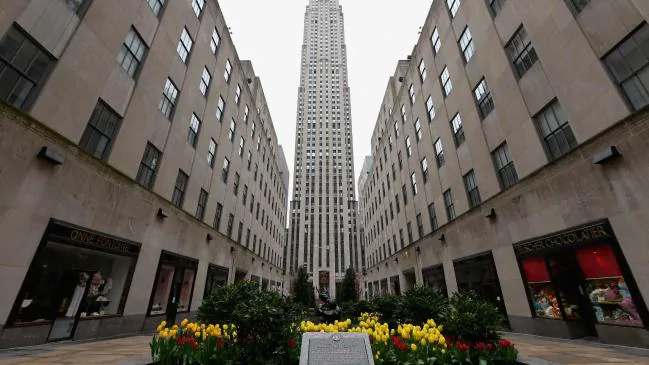
An empty Rockefeller Center on April 09, 2020 in New York City. Picture: Angela Weiss / AFP.Source:AFP
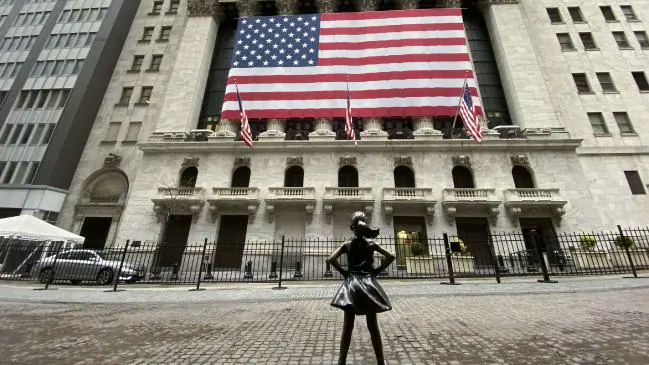
Flags fly at full staff outside the NYSE on April 09, 2020 in New York City. Picture: Kena Betancur/Getty Images/AFP.=Source:AFP
There are few locals left who don’t personally know someone directly affected by the virus. A few weeks ago I was the exception, but I now have several friends who have contracted COVID-19, some of whom required a stay in hospital because their symptoms were severe.
Not one of them were previously considered to be in the “vulnerable” category. Everywhere you look, there are signs that the virus – dubbed by US President Donald Trump as “the invisible enemy” – is here. Among the most chilling sights are the refrigerated trucks, lined up on city streets for the purposes of storing bodies, as morgues become overwhelmed.
Even if you choose to turn a blind eye, the sounds of the crisis are impossible to ignore.
As infections surge, emergency sirens pierce through the silence of Manhattan’s abandoned major avenues and echo down its empty streets at all hours of the day.
When one ends, another begins. Several often blare at once. It’s a sobering reminder of the distress so many people are in and the lives at stake.
But like many other cities around the world ravaged by this disease, there have been endless displays of humanity.
Residents cheering from their windows, clanging pots, blowing horns and applauding every night at 7pm in a show of support for the health workers on the coronavirus frontline; flags flying at half mast in honour of the many people who have lost their lives to COVID-19; restaurant owners making and delivering free meals to hospital workers and the homeless.
Friends and colleagues picking up the phone to check in on one another; light tributes illuminating the city’s iconic skyline in honour of essential workers risking everything and working themselves to the point of exhaustion for the greater good of others
The camaraderie and community spirit that have gotten New Yorkers through other disasters and tragedies will undoubtedly see them through this one as well. But just when we will reach the end is anyone’s guess.
Source: News

